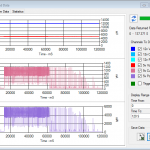HDD vs PCIe & SATA SSD FILE COPY
Finally we decided to test out some of the differences in real world use between an HDD and SSD, so we created a simple test. First we chose three drives, a SATA SSD, PCIe SSD, and standard 7,200RPM HDD. To compare them we will be looking at idle power consumption and active power consumption via a 21GB file copy. When accounting for the power consumption we will also be taking into consideration background activity such as garbage collection. We will be taking measurement until each drive returns back to an idle state.
Below are the results screenshots from Test Monkey.
The above results are somewhat in line with what we were expecting, however, we did discover something interesting. We can see that the consumption tapers off well after the file transfer is complete. Furthermore, we can see similar with the HDD. After the initial file transfer is finished, the HDD is still consuming power for the same length of time Windows showed the transfer took to complete.
The chart above shows how each drive compared. In terms of idle we can see that the SATA SSD was the most efficient coming in at just 0.24W, followed by the PCIe SSD at 1.72W. The HDD on the other hand consumes almost 3x the amount of power of the PCIe SSD and over 20x the power of the SATA drive! Again when looking at the active copy consumption it follows a similar trend, however, because the copy was from a SATA based SSD to the destination drives, the PCIe SSD could have possibly gone up higher in consumption and finished the transfer faster.
Looking at the time span we can see that the SSDs took just about 2 minutes to return back to idle, again, the PCIe SSD could have possibly done so faster, however, the HDD took about 5 minutes! Considering that idle accounts for around 85% of a drive’s power state in a desktop system we can see that SSDs in general are much better options for those who are power conscious.
FINAL THOUGHTS
Thanks to Quarch Technology, The SSD Review is now able to accurately analyze the power consumption of any flash storage device out there. The XLC Programmable Power Module is quite an impressive device and we are glad we can now utilize it in our reports. We could go into much more detail about this device, but chose not to within reason of this article.
We are still thinking of ways to implement consumption data. We can easily follow the old format of listing startup, idle, and different I/O and file size consumption on a bar graph, but with this device, it opens up so many more possibilities. While we may start off with what we have always done, but we may also start showing efficiency in terms of IOPS per watt or power consumption over a standardized benchmark to compare different drives. Beyond that, there are many more possibilities for us to look into and we are glad we can seriously take power consumption into consideration.
If you have any questions or feedback on what kind of metrics you are interested in seeing in our future reports, please leave a comment in the section below. We are always happy to answer your questions and cater our reviews to you, the reader.
If you would like to learn more about this device or others that Quarch Technology manufactures, visit their website at www.quarch.com.
 The SSD Review The Worlds Dedicated SSD Education and Review Resource |
The SSD Review The Worlds Dedicated SSD Education and Review Resource | 


interesting…keep up the good work